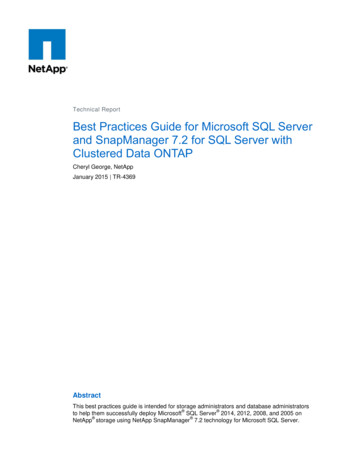
Transcription
-Technical ReportBest Practices Guide for Microsoft SQL Serverand SnapManager 7.2 for SQL Server withClustered Data ONTAPCheryl George, NetAppJanuary 2015 TR-4369AbstractThis best practices guide is intended for storage administrators and database administrators to help them successfully deploy Microsoft SQL Server 2014, 2012, 2008, and 2005 on NetApp storage using NetApp SnapManager 7.2 technology for Microsoft SQL Server.
TABLE OF CONTENTS12345672Executive Summary. 41.1Purpose and Scope .41.2Audience .41.3Caveats .5Introduction to SQL Server 2014 . 52.1In-Memory OLTP Capabilities (Hekaton) .52.2SQL Server Data Files in Windows Azure.52.3AlwaysOn Enhancements .62.4Buffer Pool Extensions .62.5Security Enhancements .6Database and Storage . 73.1Aggregates.73.2Volumes .73.3LUNs .83.4SMB Shares .10Storage Efficiency and Manageability . 124.1Snapshot Copies.124.2Thin Provisioning .134.3Space Guarantee .134.4Space Reclamation .144.5Fractional Reserve .144.6NetApp FlexClone .154.7NetApp Deduplication .164.8NetApp SnapMirror .16NetApp Backup and Restore Solution for Microsoft SQL Server . 175.1SnapManager 7.2 for SQL Server .175.2Backup .225.3Restore .275.4Reseeding Availability Groups .28Virtualization . 286.1Hyper-V .286.2VMware .28MetroCluster with Data ONTAP 8.3 . 30Best Practices Guide for Microsoft SQL Server and SnapManager 7.2 for SQL Server withClustered Data ONTAP 2015 NetApp, Inc. All Rights Reserved.
8Best Practices for Ongoing Management and Monitoring . 30References . 31LIST OF TABLESTable 1) Database layout on SMB shares. .10Table 2) Volume guarantee set to none.14Table 3) Using autogrow and autodelete. .15LIST OF FIGURESFigure 1) Basic SQL Server database design for NetApp storage system. .11Figure 2) SQL Server database design for NetApp storage systems: tempdb on dedicated volume. .12Figure 3) SQL Server database design for NetApp storage systems: transaction logs on dedicated volume. .12Figure 4) Clone of clone operation. .18Figure 5) SMSQL clone wizard will not display level-2 clones. .18Figure 6) Split clone database operation. .20Figure 7) Delete clone database operation.21Figure 8) SMSQL clone wizard displaying only level-2 clones for deletion. .22Figure 9) Backup wizard allowing backup of cloned databases with clone level displayed. .23Figure 10) Backup management groups settings in the SMSQL GUI. .25Figure 11) Backup grouping setting in the SMSQL GUI. .263Best Practices Guide for Microsoft SQL Server and SnapManager 7.2 for SQL Server withClustered Data ONTAP 2015 NetApp, Inc. All Rights Reserved.
1 Executive SummaryMany organizations use Microsoft SQL Server as a back-end datastore for mission-critical businessapplications. The latest release, SQL Server 2014, delivers manageability, increased availability, andperformance. Availability is improved through the AlwaysOn Availability Groups feature, which makesSQL Server capable of hosting up to eight secondary replicas; performance is improved through the newSQL Server in-memory capabilities, which are built into the database for online transaction processing(OLTP), and through features for data warehousing workloads and buffer pool extension (BPE). BPEextends the database engine buffer pool cache, usually through the use of solid-state drives (SSDs).SQL Server implementations have become more complex and require more reliability than ever before.Database service-level agreements (SLAs) require predictable performance, and outages are disruptiveand costly for database consumers. The underlying physical storage architecture that supports SQLServer is expected to scale to meet growing capacity needs, but bottlenecks arise frequently and backupprocesses get slower as databases grow. SQL Server databases are growing significantly large to meetthe needs of today’s organizations. At the same time, business requirements dictate shorter backup andrestore windows.Using the built-in SQL Server streaming backup and recovery solution causes restore times to require thebackup time plus additional time to replay any transaction logs. The larger the database, the harder it is tomeet organizational SLAs. Failure to meet the organization’s SLAs can have a direct and devastatingeffect on revenue and customer goodwill. It is clear that conventional backup mechanisms simply do notscale, and many organizations have sought new, innovative solutions to comply with increasinglystringent business requirements.1.1Purpose and ScopeThis document describes best practices and offers insight into design considerations for deploying SQL Server on NetApp storage systems running NetApp clustered Data ONTAP software, with the goal ofachieving effective and efficient storage deployment and end-to-end data protection and retentionplanning. The scope of this guide is limited to technical design guidelines based on the design principlesand preferred standards that NetApp recommends for storage infrastructure when deploying SQL Server.The end-to-end implementation is out of the scope of this report.The best practices and recommendations described in this guide enable SQL Server architects andNetApp storage administrators to plan a highly available and easy-to-manage SQL Server environmentand to meet stringent SLAs. NetApp assumes that the reader has working knowledge of the followingtopics: The NetApp clustered Data ONTAP operating system NetApp SnapDrive for Windows data management software NetApp SnapManager for SQL Server (SMSQL) technology Microsoft SQL Server architecture and administration Microsoft SQL Server For configuration compatibility across the NetApp stack, refer to the NetApp Interoperability Matrix Tool(IMT).1.2AudienceThis report is intended for experienced SQL Server administrators, IT managers, and storageadministrators who reviewed the following product documentation: NetApp SnapDrive for Windows SnapManager for Microsoft SQL Server Clustered Data ONTAP4Best Practices Guide for Microsoft SQL Server and SnapManager 7.2 for SQL Server withClustered Data ONTAP 2015 NetApp, Inc. All Rights Reserved.
Readers should ideally have a good understanding of the SQL Server storage architecture andadministration as well as of SQL Server backup and restore concepts. For more information about theSQL Server architecture, refer to Books Online for SQL Server 2014.1.3CaveatsThe following caveats apply to the information in this technical report: Applications that use SQL Server as a back end might have specific requirements dictated by theapplications’ design characteristics and are beyond the scope of this technical report. For applicationspecific guidelines and recommendations relating to physical and logical database layout, contactyour application provider. Best practices for managing SQL Server environments focus exclusively on the latest NetApp storageoperating system, the Data ONTAP architecture.22.1Introduction to SQL Server 2014In-Memory OLTP Capabilities (Hekaton)New in SQL Server 2014, the In-Memory OLTP engine can significantly improve OLTP databaseapplication performance. In-Memory OLTP is a memory-optimized database engine integrated into theSQL Server engine, optimized for OLTP.The In-Memory OLTP engine is designed for extremely high session concurrency of OLTP transactionsthat are driven from a highly scaled-out middle tier. To achieve this performance, the engine uses latchfree data structures and optimistic, multiversion concurrency control. The result is predictable,submillisecond low latency and high throughput with linear scaling for database transactions. The actualperformance gain depends on many factors, but 5-to-20 times performance improvements are common.In-Memory OLTP runs only in the 64-bit version of SQL Server 2014 Enterprise Edition. The committedcheckpoint file for durable tables must be configured to run on the fastest disks in the storage controller.2.2SQL Server Data Files in Windows Azure SQL Server Data Files in Windows Azure provides native support for SQL Server database files storedas Windows Azure blobs. It allows you to create a database in SQL Server that runs on the premises or ina virtual machine (VM) in Windows Azure with a dedicated storage location for your data in WindowsAzure blob storage.SQL Server Data Files in Windows Azure simplifies the task of moving databases between machinesthrough detach and attach operations. In addition, it provides an alternative storage location for yourdatabase backup files by allowing you to restore from or to Windows Azure storage. The feature enablesseveral hybrid solutions and provides benefits for data virtualization, data movement, data security, anddata availability, in addition to low cost and easy maintenance for high availability and elastic scaling.Hosting a SQL Server Database in a Windows Azure Virtual MachineSQL Server 2014 includes a new wizard for deploying SQL Server databases to a Windows Azure VM.The wizard performs a full database backup operation—it always copies the complete database schemaand the data from a SQL Server user database. The wizard also automatically configures the WindowsAzure VM, so no manual preconfiguration of the VM is required.5Best Practices Guide for Microsoft SQL Server and SnapManager 7.2 for SQL Server withClustered Data ONTAP 2015 NetApp, Inc. All Rights Reserved.
2.3AlwaysOn EnhancementsSQL Server 2014 adds the following enhancements to the AlwaysOn Availability Groups feature: An Add Azure Replica wizard simplifies the creation of hybrid solutions for AlwaysOn availabilitygroups. The maximum number of secondary replicas is increased from four to eight. When disconnected from the primary replica or during cluster quorum loss, readable secondaryreplicas remain available for read workloads. Failover cluster instances (FCIs) can use Cluster Shared Volumes (CSVs) as cluster-shared disks.Note:2.4SnapManager for SQL Server does not support CSV disks.Buffer Pool ExtensionsThe buffer pool extension provides seamless integration of a nonvolatile RAM extension with thedatabase engine buffer pool to significantly improve I/O throughput. The buffer pool extension is notavailable in every SQL Server edition. It is available only with the 64-bit SQL Server Standard, BusinessIntelligence, and Enterprise editions.The buffer pool extension feature extends the buffer pool cache with nonvolatile storage (usually SSDs).The extension allows the buffer pool to accommodate a larger database working set, forcing the paging ofI/Os between the RAM and the SSDs and effectively offloading small random I/Os from mechanical disksto SSDs. Because of the lower latency and better random I/O performance of SSDs, the buffer poolextension significantly improves I/O throughput.The buffer pool extension feature offers the following benefits: Increased random I/O throughput Reduced I/O latency Increased transaction throughput Improved read performance with a larger hybrid buffer pool A caching architecture that can take advantage of existing and future low-cost memoryBest Practices Make sure that an SSD-backed LUN is presented to the SQL Server host so that it can be used asa buffer pool extension target disk. The extension file must be the same size or larger than the buffer pool.2.5Security EnhancementsSQL Server 2014 has three new security levels: CONNECT ANY DATABASE is a new server-level permission. Grant CONNECT ANY DATABASE to alogin that must connect to all existing databases and to any new databases created in the future.CONNECT ANY DATABASE does not grant any permission in any database beyond permission toconnect. Combine this permission with SELECT ALL USER SECURABLES or VIEW SERVER STATEto allow an auditing process to view all data or all database states on the SQL Server instance. IMPERSONATE ANY LOGIN is a new server-level permission. When granted, it allows a middle-tierprocess to impersonate the account of clients connecting to it as it connects to databases. When thispermission is denied, a high privileged login can be blocked from impersonating other logins. Forexample, a login with CONTROL SERVER permission can be blocked from impersonating other logins. SELECT ALL USER SECURABLES is a new server-level permission. When this permission isgranted, a login such as an auditor can view data in all databases to which the user can connect.6Best Practices Guide for Microsoft SQL Server and SnapManager 7.2 for SQL Server withClustered Data ONTAP 2015 NetApp, Inc. All Rights Reserved.
3 Database and StorageThe combination of NetApp storage solutions and Microsoft SQL Server enables the creation ofenterprise-level database storage designs that can meet today’s most demanding applicationrequirements. To optimize both technologies, it is vital to understand the SQL Server I/O pattern andcharacteristics. A well-designed storage layout for a SQL Server database supports the performance ofSQL Server and the management of the SQL Server infrastructure. A good storage layout also allows theinitial deployment to be successful and the environment to grow smoothly over time as the businessgrows.3.1AggregatesAggregates are the primary storage containers for NetApp storage configurations and contain one ormore RAID groups consisting of both data disks and parity disks. Starting with Data ONTAP 8.0,aggregates are either 32-bit or 64-bit format. With large-sized SATA disks, increased spindle countcaused by increased disk count can help maximize performance and maintain high storage efficiency dueto the large-size thresholds.NetApp has performed various tests by using shared and dedicated aggregates with data files andtransaction log files separated and I/O workload characterization. The tests show that one largeaggregate with more RAID groups and spindles optimizes and improves storage performance and iseasier for administrators to manage for two reasons: One large aggregate makes the I/O abilities of all spindles available to all files. One large aggregate enables the most efficient use of disk space.For high availability (HA), place the SQL Server AlwaysOn availability group secondary synchronousreplica on a separate storage virtual machine (SVM) in the aggregate. For disaster recovery purposes,place the asynchronous replica on an aggregate that is part of a separate storage cluster in the DR site, with content replicated using NetApp SnapMirror technology.Best PracticeNetApp recommends having at least 10% free space available in an aggregate for optimal storageperformance.3.2Volumes NetApp FlexVol volumes are created and reside inside aggregates. Many volumes can be created in asingle aggregate, and each volume can be expanded, shrunk, or moved between aggregates.Volume Design ConsiderationsBefore you create a database volume design, it is important to understand how the SQL Server I/Opattern and characteristics vary depending on the workload and on the backup and recoveryrequirements.7Best Practices Guide for Microsoft SQL Server and SnapManager 7.2 for SQL Server withClustered Data ONTAP 2015 NetApp, Inc. All Rights Reserved.
Best Practices Use FlexVol volumes to store SQL Server database files, and avoid sharing volumes betweenhosts. Use NTFS mount points instead of drive letters to surpass the 26-drive-letter limitation in Windows.When using volume mount points, a general recommendation is to give the volume label the samename as the mount point. Configure a volume autosize policy, when appropriate, to help prevent out-of-space conditions. Enable read reallocation on the volume when the SQL Server database I/O profile consists ofmostly large sequential reads, such as with decision support system workloads. Read reallocationoptimizes the blocks to provide better performance. If you install SQL Server on an SMB share, make sure that Unicode is enabled on the SMB/CIFSvolumes for creating folders. Set the NetApp Snapshot copy reserve value in the volume to zero for ease of monitoring from anoperational perspective. Disable storage Snapshot copy schedules and retention policies. Instead, use SnapManager forSQL Server to coordinate Snapshot copies of the SQL Server data volumes. Place the SQL Server system databases on a dedicated volume or VMDK, because colocatingsystem databases with user databases, including availability group databases, prevents Snapshotbackups of the user databases. Backups of system databases are streamed into the SnapInfoLUN. This LUN is typically the same volume or VMDK that hosts the Windows operating systemfiles and SQL Server binaries, which are random read/write workloads. Reporting and decision support system (DSS)–type workloads use the tempdb extensively as atemporary workspace, especially for I/O-intensive DBCC CHECKDB operations against largedatabases, which causes spooling into the tempdb. Therefore, place this database on a dedicatedvolume with a separate set of spindles on which Snapshot copies are not created, because thetempdb is recreated every time SQL Server is restarted, thereby saving storage space. In largeenvironments in which volume count is a challenge, you can consolidate tempdb into fewervolumes and store it in the same volume as other system databases after careful planning. Place user data files (.mdf) on separate volumes or VMDK because they are random read/writeworkloads. It is common to create transaction log backups more frequently than database backups.For this reason, place transaction log files (.ldf) on a separate volume or VMDK from the data filesso that independent backup schedules can be created for each. This separation also isolates thesequential write I/O of the log files from the random read/write I/O of data files. This significantlyimproves SQL Server performance because it allows multiple physical devices to concurrentlyservice requests. Place the database and backups on separate volumes to enable recovery of databases in case ofdevice failure. Doing so also allows isolation of read-write I/O against the production database fromwrite I/O during backup operations. Create the SnapManager share on the dedicated FlexVol volume in which SnapManager copiestransaction logs for the availability group database. These logs are required to perform an up-tothe-minute restore of the availability group databases on another node. For complete details on volume design considerations for SQL Server environments, refer to BooksOnline for SQL Server 2014 and SnapManager 7.2 for SQL Server Installation and Setup Guide.3.3LUNsSnapInfo DirectoryThe SnapInfo directory is the main repository of the SnapManager for SQL Server (SMSQL) software. Allthe metadata related to the SMSQL instance installed on a host (such as SnapManager backup8Best Practices Guide for Microsoft SQL Server and SnapManager 7.2 for SQL Server withClustered Data ONTAP 2015 NetApp, Inc. All Rights Reserved.
metadata, stream-based backups of system databases, and transaction log backups) is kept in theSnapInfo directory. The size of the SnapInfo LUN is calculated as follows:Size of SnapInfo LUN ((system database size (maximum DB LDF size daily log change rate %)) (Snapshot copy retention) (1-LUN overhead space %)The SnapInfo LUN sizing formula assumes the following: A system database backup that does not include the tempdb database A 10% LUN overhead spaceThe amount of data in the SnapInfo directory depends on the size of the backups and the number of daysthat backups are retained. The SnapInfo directory can be configured at any time by running theconfiguration wizard. Although using a single SnapInfo directory reduces complexity, separate SnapInfodirectories offer flexibility for applying varying retention and archiving policies to databases. You can back up SQL Server databases to a NetApp SnapVault location and perform the followingoperations: Restore all LUNs in a volume. Restore a single LUN from the vault. Access the latest Snapshot copy of a LUN directly from the backup vault.Note:Direct access is read-only.Best Practices Place the SnapInfo directory on a LUN in a dedicated volume that is not shared by any other typeof data that can potentially corrupt the backup Snapshot copies taken by SMSQL. Do not place user databases or system databases on a LUN that hosts mount points. Always use the SMSQL configuration wizard to migrate databases to NetApp storage so that thedatabases are stored in valid locations with SnapInfo configured appropriately. This enablessuccessful SMSQL backup and restore operations. Keep in mind that the migration process isdisruptive and can cause the databases to go offline during the migration process.The following conditions must be in place to enable failover cluster instances (FCIs) of SQL Server:9 The SnapInfo LUN must be a cluster disk resource in the same cluster group as the SQL Serverinstance being backed up by SnapManager. User databases must be placed on shared LUNs that are physical disk-cluster resources assignedto the cluster group associated with the SQL Server instance. Make sure that the user database and the SnapInfo directory are on separate volumes to preventthe retention policy from overwriting Snapshot copies when these are used with SnapVaulttechnology. Make sure that SQL Server databases reside on LUNs separate from LUNs that havenondatabase files, such as full-text search-related files. Placing database secondary files (as part of a file group) on separate volumes improves theperformance of the SQL Server database. This separation is valid only if the database’s .mdf filedoes not share its LUN with any other .mdf files. If any database file groups share the same LUNs, the database layout must be identical for alldatabases. However, this restriction is not applicable when the Unrestricted Database Layoutoption is enabled.Best Practices Guide for Microsoft SQL Server and SnapManager 7.2 for SQL Server withClustered Data ONTAP 2015 NetApp, Inc. All Rights Reserved.
3.4SMB SharesSnapManager supports SQL 2012/2014 databases on SMB shares residing on clustered Data ONTAP8.2 and later. You can set up the layout as shown in Table 1.Table 1) Database layout on SMB shares.ContentSMB shareUserDB (multiple instances)\\ CIFS servername \UserDBUserLOG (multiple instances)\\ CIFS servername \UserLogSQL Server binaries SystemDBs\\ CIFS servername \SystemDBSnapInfo\\ CIFS servername \SnapInfoNote:SQL Server 2014 does not support in-memory (Hekaton) databases on x86 platforms and onNAS configuration.For additional information, refer to Hardware and Software Requirements for Installing SQL Server 2014and Install SQL Server with SMB Fileshare as a Storage Option.Best Practices Configure the Transport Protocol Setting dialog box in SnapDrive for Windows with the informationfor connecting to the SVM (SVM IP address, user name, and password) to view all SMB shares onits CIFS server, which then becomes visible to SnapManager for SQL Server. Disable the automatic Snapshot copy scheduling configured by SnapDrive for Windows. For SnapManager to be able to recognize the database file path as a valid file path hosted onNetApp storage, you must use the CIFS server name on the storage system in the SMB share pathinstead of the IP address of the management LIF or other data LIF. The path format is \\ CIFSserver name \ share name . If the database uses the IP address in the share name,manually detach and attach the database by using the SMB share path with the CIFS server namein its share name. When provisioning volumes for SMB environments, you must create the volumes as NTFSsecurity-style volumes. Make sure that all database files (the data files, in addition to the transaction log files) reside onSMB shares instead of placing them across LUNs and SMB shares. Make sure that no antivirus scanning is performed on the SMB/CIFS shares in which SQL Serverdata is stored to avoid failed transactions due to latency. Make sure that Windows host caching is disabled on the SMB/CIFS share in which SQL Serverdata is stored to avoid corruption caused by caching. When you use availability groups, the transaction logs are streamed to a shared network locationthat is a SnapManager SMB share accessible by all the replicas. Therefore, verify that this CIFSshare is sized to accommodate the transaction logs.Database Storage DesignThis section contains a few examples of SQL Server des
Hosting a SQL Server Database in a Windows Azure Virtual Machine SQL Server 2014 includes a new wizard for deploying SQL Server databases to a Windows Azure VM. The wizard performs a full database backup operation—it always copies the complete database schema and the data from a SQL Server user database.










